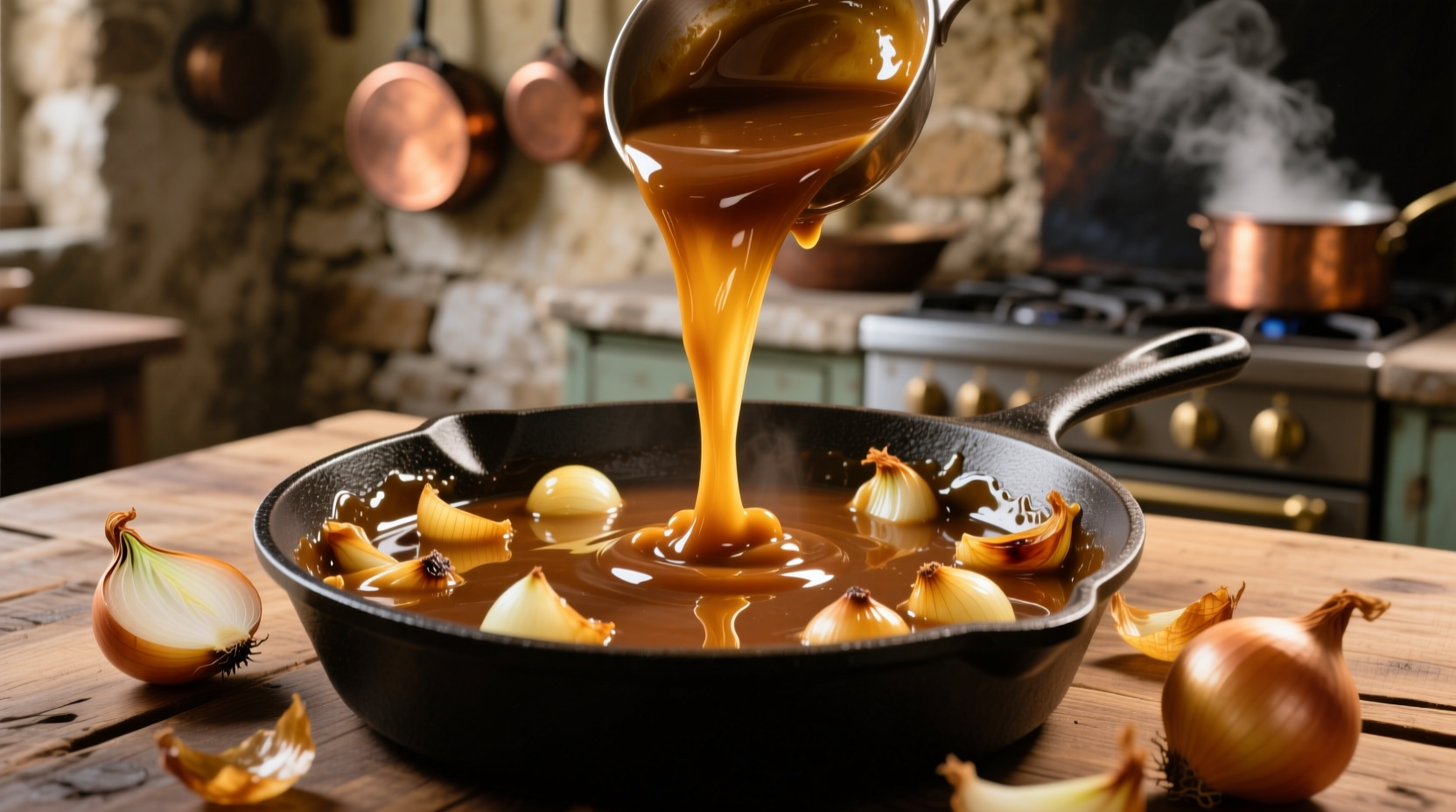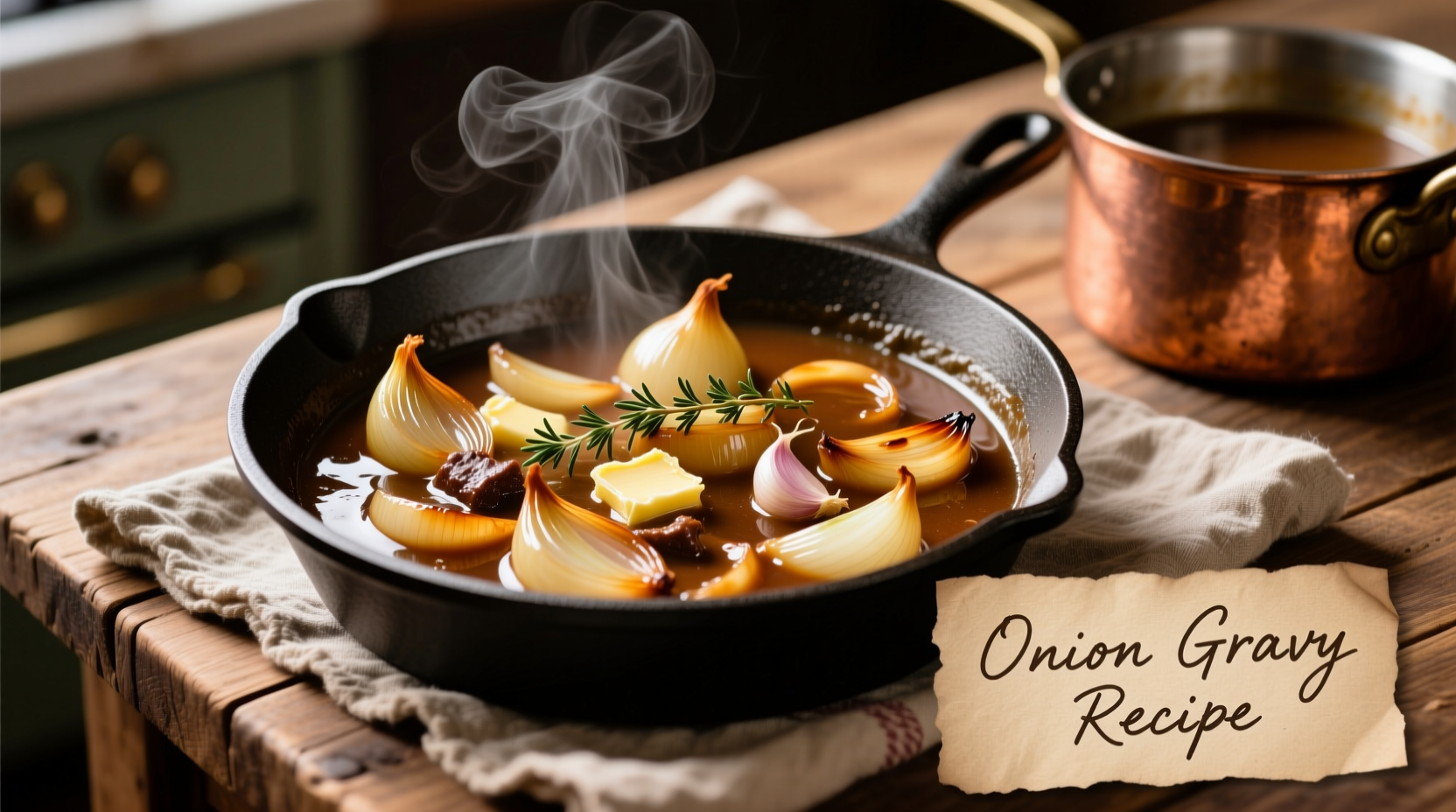Nothing transforms a simple meal like a rich, flavorful onion gravy. Whether you're serving it over roast beef, mashed potatoes, or Yorkshire puddings, this easy homemade onion gravy recipe delivers restaurant-quality results with pantry staples. Forget store-bought versions that lack depth—our method creates a deeply caramelized, umami-rich gravy that takes just 45 minutes from start to finish.
The Science Behind Perfect Caramelization
Creating exceptional onion gravy starts with understanding the Maillard reaction—the chemical process that develops complex flavors when onions cook slowly. According to research from the University of Illinois Food Science Department, cooking onions at 300-350°F for 25-30 minutes triggers optimal flavor development without burning. This slow transformation converts natural sugars into hundreds of flavor compounds that give properly caramelized onions their signature sweet-savory depth.

Essential Ingredients for Flavorful Onion Gravy
The magic happens with just six ingredients, but each plays a critical role:
- Yellow onions (2 lbs) - Their balanced sugar-to-water ratio creates perfect caramelization
- Unsalted butter (3 tbsp) - Adds richness and helps control browning
- All-purpose flour (3 tbsp) - Creates the roux base for thickening
- Beef stock (2 cups) - Use low-sodium for better flavor control
- Dry red wine (¼ cup) - Adds complexity (substitute with additional stock if preferred)
- Worcestershire sauce (1 tsp) - Provides umami depth
| Thickening Method | Texture Result | Flavor Impact | Best For |
|---|---|---|---|
| Traditional roux (flour + fat) | Smooth, velvety | Neutral base | Classic roast dinners |
| Cornstarch slurry | Glossy, slightly sticky | Mild, clean | Gluten-free needs |
| Arrowroot powder | Clear, silky | Nearly flavorless | Fine dining presentations |
| Reduction only (no thickener) | Naturally thickened | Most intense onion flavor | Special occasion gravies |
Step-by-Step Cooking Process
Phase 1: Perfect Onion Caramelization (25-30 minutes)
- Thinly slice 2 lbs yellow onions (about 4 medium) using a mandoline for consistent thickness
- Melt 3 tbsp butter in a heavy-bottomed skillet over medium-low heat
- Add onions and ½ tsp salt to draw out moisture
- Cook uncovered, stirring every 5 minutes, until onions turn deep golden brown
- Reduce heat if onions brown too quickly—patience is key for caramelized onion gravy recipe success
Phase 2: Building Flavor Foundations (10 minutes)
- Add ¼ cup dry red wine to deglaze the pan, scraping up browned bits
- Cook until wine completely evaporates (about 3 minutes)
- Stir in 3 tbsp flour to create the roux, cooking for 2 minutes to eliminate raw flour taste
- Gradually whisk in 2 cups warm beef stock until smooth
- Add 1 tsp Worcestershire sauce and optional 1 tsp soy sauce for extra umami
Phase 3: Final Simmer and Seasoning (5-10 minutes)
- Simmer gently for 5-10 minutes until gravy reaches desired consistency
- Season with salt and freshly ground black pepper to taste
- For extra richness, stir in 1 tbsp cold butter off-heat
- Strain through a fine-mesh sieve for ultra-smooth onion gravy for roast beef
- Serve immediately or store for later use
Avoid These 3 Common Onion Gravy Mistakes
Mistake #1: Rushing the Caramelization
Cooking onions too quickly creates bitter, unevenly browned results. True caramelization requires patience—turning the heat up won't speed the process but will burn the onions. Professional chefs at the Culinary Institute of America recommend maintaining a steady medium-low heat throughout.
Mistake #2: Adding Cold Liquid to Hot Roux
Pouring cold stock into a hot roux causes immediate clumping. Always warm your stock slightly before adding it gradually while whisking constantly. This technique ensures a perfectly smooth thick onion gravy without flour lumps.
Mistake #3: Underseasoning at the End
Gravy needs proper seasoning to shine. Taste and adjust salt just before serving—seasoning too early can lead to over-salting as liquid reduces. A splash of sherry vinegar (½ tsp) can brighten flavors if the gravy tastes flat.
Variations for Every Dietary Need
Vegetarian Onion Gravy
Substitute beef stock with mushroom or vegetable stock and add 1 tbsp nutritional yeast for umami depth. This vegetarian onion gravy recipe works beautifully with roasted root vegetables.
Gluten-Free Option
Replace flour with 1½ tbsp cornstarch mixed with 2 tbsp cold stock. Add during the final simmer after deglazing for a perfectly thickened gravy that's still gluten-free.
Quick Weeknight Version
When time is short, use 1 large onion plus 1 tbsp onion powder to boost flavor. This easy homemade onion gravy recipe takes just 20 minutes while still delivering satisfying depth.
Serving Suggestions and Storage
This versatile gravy shines with:
- Traditional roast beef and Yorkshire puddings
- Poured over creamy mashed potatoes
- As a base for poutine (with cheese curds and fries)
- Drizzled over meatloaf or shepherd's pie
Storage: Cool completely and store in an airtight container for up to 5 days in the refrigerator. For longer storage, freeze in ice cube trays then transfer to freezer bags for up to 3 months. Reheat gently over low heat, adding small amounts of stock if needed to restore consistency.
Historical Evolution of Onion Gravy
Onion gravy has evolved significantly through culinary history:
- 1700s: British cooks developed early versions using beef drippings and onions
- 1800s: French chefs refined techniques, emphasizing slow caramelization
- Early 1900s: American cookbooks popularized simplified versions for home cooks
- Post-WWII: Instant gravy mixes led to decline in homemade versions
- 2000s-Present: Culinary revival focusing on traditional techniques and quality ingredients
Frequently Asked Questions
Can I make onion gravy without wine? Absolutely. Substitute with additional beef stock plus 1 tsp balsamic vinegar for complexity. The wine adds depth but isn't essential for a delicious onion gravy for mashed potatoes.
Why is my gravy watery? This usually happens when the roux hasn't cooked long enough or too much liquid was added. Simmer uncovered for 5-10 minutes to reduce, or create a slurry with 1 tsp cornstarch and 1 tbsp cold water to thicken quickly.
How do I fix bitter onion gravy? Bitterness comes from burned onions. Start over with fresh onions, cooking over lower heat. If already made, add 1 tsp sugar or 2 tbsp apple cider to balance flavors in your how to make onion gravy from scratch attempt.











 浙公网安备
33010002000092号
浙公网安备
33010002000092号 浙B2-20120091-4
浙B2-20120091-4